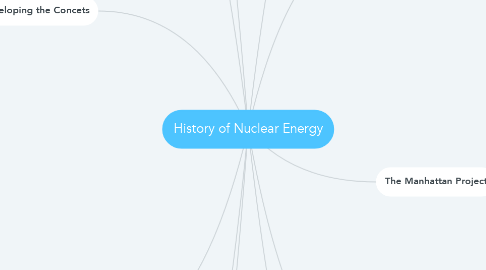History of Nuclear Energy
by Jarrod Judge

1. Nuclear Physics in Russia
1.1. Work on radioactive minerals found in central Asia began in 1900
1.2. The 1917 Revolution gave a boost to scientific research and over 10 physics institutes were established in major Russian towns
1.3. Germany's invasion of Russia in 1941 turned much of this fundamental research to potential military applications
2. Conceiving the Atomic Bomb
2.1. Peierls and Frisch gave a major impetus to the concept of the atomic bomb in a three-page document known as the Frisch-Peierls Memorandum
2.2. 5kg of pure U-235 could make a very powerful atomic bomb equivalent to several thousand tonnes of dynamite
2.3. They proposed thermal diffusion as a suitable method for separating the U-235 from the natural uranium
2.4. Two important developments came from the work at Cambridge. The first was experimental proof that a chain reaction could be sustained with slow neutrons in a mixture of uranium oxide and heavy water
2.5. When U-235 and U-238 absorb slow neutrons, the probability of fission in U-235 is much greater than in U-238
3. Developing the Concets
3.1. 1940 the MAUD committee was founded
3.2. The whole scheme for a bomb was feasible provided highly enriched U-235 could be obtained
3.3. The MAUD report recommended that the work should be continued with high priority in cooperation with the Americans, even though they seemed to be concentrating on the future use of uranium for power and naval propulsion
3.4. The predicted critical size for a sphere of U-235 metal was about 8kg, which might be reduced by use of an appropriate material for reflecting neutrons
3.5. MAUD Report concluded that the controlled fission of uranium could be used to provide energy in the form of heat for use in machines, as well as providing large quantities of radioisotopes which could be used as substitutes for radium
3.6. After the attack on Pearl Harbor in December of 1941, the huge resources of the USA were then applied without reservation to developing atomic bombs
4. The Soviet Bomb
4.1. After the defeat of Nazi Germany in May 1945, German scientists were "recruited" to the bomb program to work in particular on isotope separation to produce enriched uranium
4.2. November 1945 of a new city in the Urals which would house the first plutonium production reactors -- Chelyabinsk-40 (Later known as Chelyabinsk-65 or the Mayak production association)
4.3. The first of five reactors at Chelyabinsk-65 came on line in 1948. This town also housed a processing plant for extracting plutonium from irradiated uranium
4.4. In August 1947 a test site was established near Semipalatinsk in Kazakhstan and was ready for the detonation two years later of the first bomb, RSD-1
5. Nuclear Energy goes Commerical
5.1. The boiling water reactor (BWR) was developed by the Argonne National Laboratory, and the first one, Dresden-1 of 250 MWe, designed by General Electric
5.2. Canadian reactor development headed down a quite different track, using natural uranium fuel and heavy water as a moderator and coolant
5.3. France started out with a gas-graphite design
5.4. In 1964 the first two Soviet nuclear power plants were commissioned
5.5. In Kazakhstan the world's first commercial prototype fast neutron reactor (the BN-350) started up in 1972, producing 120 MW of electricity and heat to desalinate Caspian seawater
5.6. Today 60% of the world capacity is PWR and 21% BWR
6. Nuclear Revival
6.1. The awareness of the importance of energy security, and thirdly is the need to limit carbon emissions due to concern about global warming
6.2. In the USA the 2005 Energy Policy Act provided incentives for establishing new-generation power reactors there
7. Exploring the Nature of the Atom
7.1. Uranium was discovered in 1789 by Martin Klaproth
7.2. Ionising radiation was discovered by Wilhelm Rontgen in 1895
7.3. Pitchblende: an ore containing radium and uranium
7.4. In 1932 James Chadwick discovered the neutron
7.5. 1938 Otto Hahn and Fritz Strassmann discover atomic fission
8. Harnessing Nuclear Fission
8.1. Hahn and Strassmann showed that fission not only released a lot of energy but that it also released additional neutrons
8.2. Bohr proposed that fission was much more likely to occur in the uranium-235 isotope
8.3. U-235 was then known to comprise only 0.7% of natural uranium, with the other 99.3% being U-238
8.4. The fission/atomic bomb concept was provided in 1939
8.5. Francis Perrin who introduced the concept of the critical mass of uranium required to produce a self-sustaining release of energy
9. The Manhattan Project
9.1. The Americans increased their effort rapidly and soon outstripped the British
9.2. The Americans were pursuing three enrichment processes in parallel, the British were only examining gaseous diffusion
9.3. A team under Robert Oppenheimer at Los Alamos in New Mexico was working on the design and construction of both U-235 and Pu-239 bombs
9.4. The first atomic device tested successfully at Alamagordo in New Mexico on 16 July 1945
10. Revival of the 'Nuclear Boiler'
10.1. The first nuclear reactor to produce electricity (albeit a trivial amount) was the small Experimental Breeder reactor (EBR-1) designed and operated by Argonne National Laboratory and sited in Idaho, USA. The reactor started up in December 1951
10.2. The Institute of Physics and Power Engineering (FEI) was set up in May 1946 to develop nuclear power technology
10.3. The main US effort was under Admiral Hyman Rickover, which developed the Pressurised Water Reactor (PWR) for naval (particularly submarine) use
11. The Nuclear Power Brown-Out
11.1. From the late 1970s to about 2002 the nuclear power industry suffered some decline and stagnation
11.2. By the late 1990s the first of the third-generation reactors was commissioned


